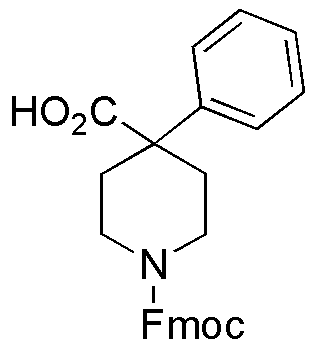Fmoc-4-phenylpiperidine-4-carboxylic acid is widely utilized in research focused on:
- Peptide Synthesis: This compound is a key building block in the synthesis of peptides, particularly in solid-phase peptide synthesis, allowing for the efficient assembly of complex peptide sequences.
- Drug Development: It serves as a crucial intermediate in the development of pharmaceutical compounds, particularly those targeting neurological disorders, enhancing the efficacy of drug candidates.
- Bioconjugation: The chemical is used in bioconjugation processes, linking biomolecules to therapeutic agents, which is essential for creating targeted drug delivery systems.
- Research in Neuroscience: Its derivatives are studied for their potential effects on neurotransmitter systems, providing insights into treatments for mental health conditions.
- Analytical Chemistry: It is employed in various analytical methods, including chromatography, to separate and identify complex mixtures, aiding in quality control and research applications.
Informations générales
Propriétés
Sécurité et réglementation
Applications
Fmoc-4-phenylpiperidine-4-carboxylic acid is widely utilized in research focused on:
- Peptide Synthesis: This compound is a key building block in the synthesis of peptides, particularly in solid-phase peptide synthesis, allowing for the efficient assembly of complex peptide sequences.
- Drug Development: It serves as a crucial intermediate in the development of pharmaceutical compounds, particularly those targeting neurological disorders, enhancing the efficacy of drug candidates.
- Bioconjugation: The chemical is used in bioconjugation processes, linking biomolecules to therapeutic agents, which is essential for creating targeted drug delivery systems.
- Research in Neuroscience: Its derivatives are studied for their potential effects on neurotransmitter systems, providing insights into treatments for mental health conditions.
- Analytical Chemistry: It is employed in various analytical methods, including chromatography, to separate and identify complex mixtures, aiding in quality control and research applications.
Documents
Fiches de données de sécurité (FDS)
La FDS fournit des informations de sécurité complètes sur la manipulation, le stockage et l’élimination du produit.
Spécifications du produit (PS)
Le PS fournit une description complète des propriétés du produit, notamment sa composition chimique, son état physique, sa pureté et les exigences de stockage. Il détaille également les plages de qualité acceptables et les applications prévues du produit.
Certificats d'analyse (COA)
Recherchez des certificats d'analyse (COA) en saisissant le numéro de lot du produit. Les numéros de lot et de lot se trouvent sur l'étiquette d'un produit, après les mots « Lot » ou « Lot de fabrication ».
Numéro de catalogue
Numéro de lot/série
Certificats d'origine (COO)
Ce certificat d'exploitation confirme le pays dans lequel le produit a été fabriqué, et détaille également les matériaux et composants utilisés et s'il est issu de sources naturelles, synthétiques ou autres sources spécifiques. Ce certificat peut être requis pour les douanes, le commerce et la conformité réglementaire.
Numéro de catalogue
Numéro de lot/série
Fiches de données de sécurité (FDS)
La FDS fournit des informations de sécurité complètes sur la manipulation, le stockage et l’élimination du produit.
DownloadSpécifications du produit (PS)
Le PS fournit une description complète des propriétés du produit, notamment sa composition chimique, son état physique, sa pureté et les exigences de stockage. Il détaille également les plages de qualité acceptables et les applications prévues du produit.
DownloadCertificats d'analyse (COA)
Recherchez des certificats d'analyse (COA) en saisissant le numéro de lot du produit. Les numéros de lot et de lot se trouvent sur l'étiquette d'un produit, après les mots « Lot » ou « Lot de fabrication ».
Numéro de catalogue
Numéro de lot/série
Certificats d'origine (COO)
Ce certificat d'exploitation confirme le pays dans lequel le produit a été fabriqué, et détaille également les matériaux et composants utilisés et s'il est issu de sources naturelles, synthétiques ou autres sources spécifiques. Ce certificat peut être requis pour les douanes, le commerce et la conformité réglementaire.


